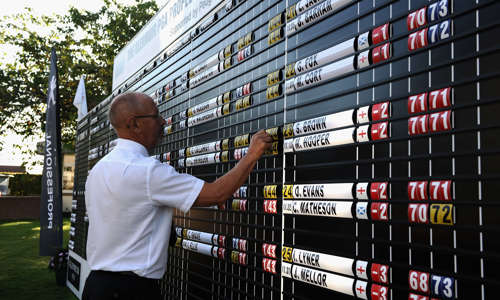Steve Robinson on the rise of in-form Matt Fitzpatrick

26/05/2022
US Open champion Matt Fitzpatrick’s obsessive attention to detail reaped rich dividends at Brookline – helping him along the way for the last four years as his performance coach is PGA Member Steve Robinson.
Matt Fitzpatrick climbed into the top 10 in the world last month following his first major win in the US Open and a top five at May’s PGA Championship.
The 27-year-old’s breakthrough season has been built on statistical improvements pretty much across the board. He’s improved his Strokes Gained in every discipline from 2021 and he leads the way in Strokes Gained Total and is fourth in Scoring Average.
Put more simply, ahead of Brookline Fitzpatrick might just have been the most underrated player in the men’s game.


Behind the scenes Fitzpatrick has it cracked. There’s swing coach Mike Walker, putting coach Phil Kenyon, Matthew Roberts looks after his strength and conditioning – he’s in the gym every day – he uses Edoardo Molinari’s stats programme and he has the legendary Billy Foster on the bag.
Pulling everything together is Sandburn Hall’s Steve Robinson who operates as Fitzpatrick’s performance coach, the same title he has with the England Women’s team. He also coaches the Yorkshire men’s and boys’ teams as well as being a regular coach – all of which has seen him being named the England Golf Coach of the Year in 2016, 17 and 21.
Robinson worked with Fitzpatrick as a Yorkshire junior and then he got into the England set-up and England started to collect data on players. Robinson was asked to interpret his data and the two began doing some performance work.

Four years ago, Fitzpatrick, along with his dad, had a meeting with Robinson about the possibility of doing a month’s work together, that soon became two months and the two of them have been together ever since.
“I organise his day-to-day work, what he’s working on, why he’s working on it and when he’s working on it. I’ll spend some time at the Bear’s Club in Florida a few times a year and I’ll make sure that his practice is done correctly and that it’s challenging and that there is some intensity to the work,” Robinson explains.
“If there is no intensity then we don’t do it. We’re not into repetitions, there has to be some skill development and some performance and technical elements.”
When the pair started working together Fitzpatrick was ranked 42nd in the world. Now he’s cracked the top 10, which is some improvement. Fitzpatrick has an attention to detail like few others – put him together with Robinson and you have the dictionary definition of discipline.

“When we got together we got a year’s data from the 2018 season and I said that I thought that there was a certain part of his game that he could improve. We were quite creative in how he used his TrackMan and what kind of performance work that we did and what baseline measurements and targets we created to do that.”
All of which sounds fairly standard (for a tournament golfer). Then they take things on to the next level and then further again.
“We’ve now got three-and-a-half-years’ practice data, so we’ve probably got over 8,000 shots recorded in practice, we’ve also got a number of shots collected from the tournaments and now we can see what practice influenced what tournament data. We’ve been down some blind alleys and spent months doing it which isn’t good, but we’ve been putting together stuff that we thought hadn’t been done before. It probably has but it was all new to us.”
When you next watch Fitzpatrick out on the course you’ll notice how his head is buried is in yardage book, his pencil in hand, as more and more notes are taken to help with further gains in the future. Caddie Foster jokes that he’s Bernhard Langer’s lovechild.
"We can look at a shot, a week, a month, a quarter or a year, we can look at what he’s doing off the tee, what he’s doing off the tee into the wind and whether the wind is off the left or right or downwind left or right. We know what he's doing with every putt. We know what pins are hurting and not hurting him, what clubs are hurting him, we can see everything.”


How data helped Matt Fitzpatrick become a major champion
With Matt, we are looking at Strokes Gained and where he might be gaining or not gaining. if he's losing strokes to the field in a particular area then it's not rocket science that he might need to work on that. We will then consider whether it's worth working on some gains – eg if he's not gaining on lob shots that shot might only come up one time every four rounds so it wouldn’t be an area where he could make a significant gain.
If you’re not able to have these stats fed to you then there are programmes that you can buy off the shelf that will give you as much detail as you want. Depending on where a player is with their development we might take a view that we won't look at Strokes Gained against the tour level or we might want to improve their Strokes Gained against themselves.
A lot of club golfers will tend to pay attention to the number of putts that they have taken and that offers some mildly useful information. Somebody might miss nine greens and chip it to six feet – whereas others will be hitting it to 20 feet – so they will hole more putts obviously. I would encourage players to look at their percentage number from certain distances and, again, there are some great programmes where you can track these things.
The thing with stats is that they're only as good as the numbers that you put in. One critical stat would be your percentage hole-out from different footage on the greens and that would give you huge indicators. You could be holing out quite well but from mid-range you might not be. So is that line or is it pace and can you match the two up? Matt will be noting down every aspect of every putt so whether it is downhill, uphill, left to right, right to left and we have a template that we fill in.
With Greens In Regulation, we're looking at what our intended target is so it might not be the flag. In a major set-up, for example, there might be three to five pins that you can go at so the majority of the time, the players will be playing away from the pin. So you might leave the ball just off the green, but on the correct side and not short-sided in the sand or some thick rough, and that is important to keep a record of.


Steve Robinson was named Coach of the Year at the England Golf Performance Awards 2021.



































